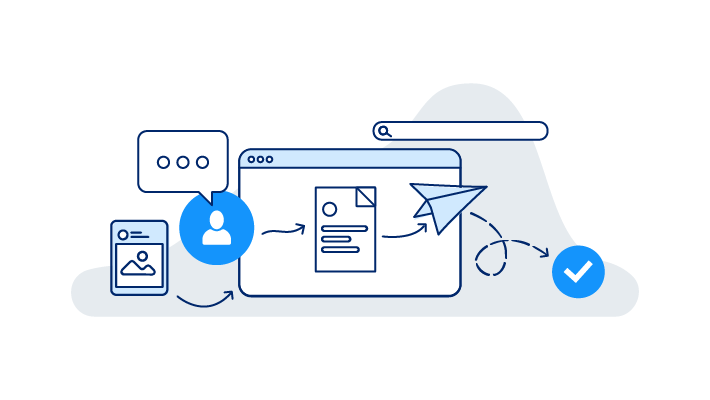
November 11, 2022
.png?width=400&height=150&name=grochalova%20(1).png) by Paula Grochalova
by Paula Grochalova

An engaging audience is within your reach.
You just need a proper content distribution channel to acquire them. If you’re writing content and nobody is reading it, it’s time to review your content distribution software needs.
Merely publishing content online isn't enough anymore. It's almost like throwing a party without distributing the invites. Your neighbors might stop by after seeing the decorations. But you put effort into picking the right playlists and preparing snacks, only for nobody to appreciate it.
That's what happens with the content you quietly leave on your blog, hoping for the best.
There might be people who would like to read your blog posts but simply don't have an idea that it exists. So once you publish your content, promoting it correctly is critical to delivering it to your target audience and adding them to your sales funnel.
Content distribution involves delivering content to the audience you created it for through promotional efforts using online media outlets and channels. In the digital age, social media plays a significant role in successfully distributing content that is either repurposed or made specifically for social platforms.
A solid content marketing and distribution strategy doesn't mean you need to publish two eBooks per week. Instead, once you create a content piece, you should devise different ways of distributing or repurposing it.
There are many possibilities for using the content you already have at your disposal. For instance, if you write an exciting piece of content, you can use the information to create an infographic, record it for a podcast, or publish excerpts of it on your Instagram stories.
The key to success in content creation and distribution is to apply the 80/20 rule. You should spend 20% of your time creating the content and 80% distributing it.
The days of bombarding customers solely with print ads are gone. Customers have become immune to this practice, and catching their attention is more challenging.
Brands and businesses realize that to attract customers, they must find other ways to catch their attention. Instead of suffocating customers with ads, brands need to provide value. Content marketing brings three times more sales-qualified leads and costs 62% less than outbound marketing. So it's at least worth a try.
What would you choose if you put yourself in a customer's shoes? Getting chased by ads in every corner of the Internet? Or learning about a product/service through a comprehensive blog post with heaps of added value?
Of course, your goal is still the same: to generate leads and increase sales. But attracting customers through valuable content works better for several reasons. It will create a trusting relationship, position you as an industry expert, educate the customer, and bring higher-quality leads in the long run.
“The next evolution of content marketing is not more content; it’s better distribution.”
Chris Penn
Co-founder and Chief Data Scientist, Trust Insights
We keep talking about distributing 'valuable' content and adding significance to the user experience. But what exactly is valuable content, and how can it be optimally distributed?
Check out some of the most popular forms of online content and how you can distribute it to the right audience.
When it comes to picking a content channel, there are mainly three types to choose from: owned, earned, and paid content distribution.
If you fear your blog posts won't reach as many people as you'd like, try publishing elsewhere. For example, you can create an account on Medium and try to engage their community of writers and readers.
Or you can submit your blog post to one of the publications on Medium. Some of them might have a considerably higher following than your blog. If you're lucky, your blog post will catch an editor's attention, and it can end up in a newsletter or on their homepage.
Here are some of the other popular content distribution channels you can explore:
Quora should not be missing in your content distribution strategy, especially if you are a B2B company. By answering questions on Quora, you position yourself as an industry expert.
Furthermore, you're lending a human face to your company by replying from an account with your name and profile picture. Avoid going overboard on content promotion in your replies. Always provide value for the reader, and if applicable, include a link to your blog post that explains the matter more thoroughly.
Additionally, you can distribute content through a newsletter. Start collecting email addresses and building a database. You'd be surprised by how many people like to receive your content in their inboxes once a month. Newsletters contain all the links and information your readers need to discover and engage with your blog posts.
Instagram stories are an excellent channel for content distribution. You can get creative with all the different features. Add funny GIFs to your stories, let your audience ask you questions, and create fun interactive polls for them. Use the swipe-up element to direct viewers to your blog/website.
Nearly a decade and a half later, Twitter still holds value and proves resourceful in spreading brand awareness and getting people to talk about what you do. With almost 330 million active monthly users, Twitter is perfect for content marketing and distribution, especially targeting the US or UK market.
Whatever content distribution channels you decide on don't matter as long as they fit your goals. Be it Facebook, Twitter, LinkedIn, or other distribution channels. You can play with sponsored posts or try posting at different times of the day.
Once you decide on all the different formats you use to play with the content, it's time to set your content distribution strategy in motion.
It may seem that sharing your content is easy. You create a Facebook post, a tweet, or an Instagram Story. There's nothing to it, is there? But there are so many things that could go wrong. So how do you develop an effective content distribution strategy?
Developing a social media marketing plan from scratch is usually a bit intimidating. But, if you get over the initial uneasy feeling and proceed step-by-step, you'll have your first social media strategy ready in no time.
There are many essential steps in creating your social media marketing plan, such as:
Can you reach your goal if you have no idea what it is? To avoid running in circles, think hard about your destination. Also, think about when and how you want to achieve that. That's why setting precise and smart goals come in handy.
How can you create and distribute content if you only have a vague idea about who your audience is? Spend time creating target personas to ensure you use the proper channels and language to reach them.
When distributing content on social media, many brands have a "go big or go home" attitude. However, being present on all social media networks doesn't guarantee success. Take another look at your target audience definition, and then choose which social media channels your audience uses the most.
This is the fun part. But it can also turn into the part where you cry, not knowing what to do first. Picking the right social media management software is essential in this step. Hit the timeline for each social media platform separately, with copies written exclusively for its audience.
Data helps you understand how the audience perceives your content. You can easily see what your followers like, which posts they comment on most, or what doesn't resonate with them. Brands are looking to become more data-driven because that helps them optimize their marketing efforts.
The Internet is full of social media strategy templates, so there's no excuse why anyone should hesitate to create their own. Maybe you will have to try a couple of times to get it right.
Whether you focus on a social media content distribution strategy or benefit from using marketing automation, it's up to you.
Content content content. There's a surplus of online content fighting for top ranks on search engines. Brands cannot afford to publish blog posts (or anything else, for that matter) and leave them sitting on their website.
Along with optimized SEO, using the right content distribution software solutions will enable you to share great content with the maximum number of people who also have the potential to be buyers.
There are several possibilities when it comes to content distribution tools. Depending on your needs, you can choose from paid or free content distribution software.
Most of these tools have mechanisms that can predict and identify the perfect target audience for your content. Your blog posts will get distributed to specific groups of people with the highest probability of being interested in them.
You can also distribute content across social media. Then it's up to you whether to use social media management software or publish everything manually (but who has time for that, right?). Social media management tools let you create and schedule posts for multiple distribution platforms at once.
It's about time businesses focus on content distribution strategies to pitch to a suitable user base. We live in a time when there's so much content produced daily that most of it will never reach the readers.
Fortunately, we're not alone in this. And there are a lot of marketing tools to help you stand out. Using content distribution software is not a luxury anymore. In the age of content marketing, we'd be lost without this strategy and the adjacent solutions.
Looking to learn more about content marketing? Find everything you need to know about creating a content marketing strategy.
This article was originally published in 2019. It has been updated with new information.

Boost your brand awareness and earn loyal customers by distributing your content to the right audience. Take the first step now with the best content distribution software.
Paula Grochalova is a Content Manager at Kontentino. She loves social media, especially when she can write about it. In her free time, she’s a knitter extraordinaire.

Boost your brand awareness and earn loyal customers by distributing your content to the right audience. Take the first step now with the best content distribution software.
Let us inhale the vapors of the Sacred Tree and pull back the mists of time to reveal one of...
 by Piper Thomson
by Piper Thomson
Do you sell physical products to other businesses? Recency, frequency, and monetary value...
 by Jessica Heald
by Jessica Heald
Product-led growth (PLG) is a go-to-market strategy that centers on the product.
 by Ioana Sima
by Ioana Sima
Let us inhale the vapors of the Sacred Tree and pull back the mists of time to reveal one of...
 by Piper Thomson
by Piper Thomson
Do you sell physical products to other businesses? Recency, frequency, and monetary value...
 by Jessica Heald
by Jessica Heald
Never miss a post.
Subscribe to keep your fingers on the tech pulse.


